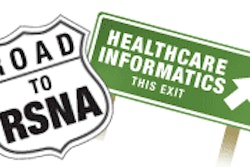DALLAS - U.S. hospitals face an increasingly bleak future in economic terms, but information technology may offer a way out by enabling them to operate more efficiently. That's the opinion of healthcare consultant Pam Arlotto, who spoke on the topic yesterday at the annual meeting of the Healthcare Information and Management Systems Society.
Arlotto is president and CEO of Maestro Strategies, a healthcare consulting firm. She reviewed the healthcare industry's increasingly intensive adoption of information technology, examined sources for health IT acquisition funds, and made suggestions for how hospitals can use IT to its full advantage.
The impact of information technology on healthcare can't be overstated, according to Arlotto.
“There is a huge tidal wave happening in this industry,” she said, noting that many CEOs feel they will have a bigger impact on the industry in a CIO position. This, she said, is evidence of IT's growing impact on healthcare.
Citing financial viability as the top concern among hospital executives, Arlotto reports that 32% of hospital CEOs fear organizational failure within the next five years. “Within five years, over half of hospitals, nationally, will be operating at a deficit,” she said.
The major reasons for declining revenue include decreasing in-patient volumes, malpractice, and competition. More than 8,000 ambulatory centers have opened up in the past several years, directly competing with the traditional acute care hospitals, requiring a reevaluation of business development strategies, Arlotto said.
Poor credit ratings also negatively impact healthcare organizations’ financial viability.
“Over 67% of our hospitals nationally have less than ‘A’ ratings,” she said, stressing the importance of credit ratings on future plans for capital expenditure, and for acquiring investment dollars.
Quoting healthcare futurist Jeff Goldsmith, Arlotto said that capital spending must shift toward technology if productivity is to be maximized. “Productivity gains represent the sole salvation of hospitals in a capital-constrained world, and they cannot be achieved without tilting the capital spending mix toward IT,” she said.
The traditional “keep-costs-low-and-beds-full strategy,” historically expected of CEOs, is no longer working, she said, advocating in its place a strategy defining profitable service lines -- new niches in healthcare delivery -- and recognition of productivity increases realized by implementing information technology. “Some of the traditionally profitable service lines [cardiology, oncology, for example] are no longer generating revenue due to restrictive reimbursement,” Arlotto said.
The top three planned capital expenditures over the next five years involve information technology. “Leading hospitals are investing in technology,” she said, citing studies showing that the “most wired” hospitals enjoy better credit ratings, increased productivity levels, and better overall profit margins.
Arlotto identified several key industry trends:
- High-performing healthcare organizations invest in technology.
- Convergence of information, medical, and building automation will bring new efficiencies.
- Boards, CEOs and executive teams are recognizing the importance of technology.
- Consumers and key business partners are demanding technology-enabled healthcare.
- Clinical technologies can transform business processes to impact quality, patient safety, cost, and customer satisfaction.
“We must all change the way we plan for and deploy technology,” Arlotto said. The main difficulty is identifying sources for healthcare IT funding. Research and grants are increasing in availability, as are traditional investment income, bonds, and philanthropic contributions. But “cash is king,” Arlotto said, and revenue generated from operations will continue to be the leading source of financing for technology initiatives. She presented statistics indicating that:
· 81% of CFOs say they currently depend on cash from operations to fund at least 25% of capital funds.
· 61% depend on internal operations to fund 50% or more of capital funds.
· 63% will be more dependent on cash from operations for future spending.
She suggested several strategies for increasing cash from operations, including better management of a hospital's core service lines and the development of new business models to incorporate new processes and technologies.
Within five years, imaging will constitute approximately 70%-80% of all procedures performed inside the typical hospital, she said. The relative impact of this type of volume on potential revenue highlights the need to take technology investment seriously.
Arlotto defined information technology as a “strategic asset—a health system resource whose value to the organization is greater than the cost of acquisition or development.”
Looking ahead, she cautioned that simply focusing on “deployment” of new processes and systems may not be the best approach. Focus instead on identifying the business drivers that are the momentum behind technology implementation, mirror the "organization’s culture and risk profile,” and consider the entire life cycle of the initiative.
By Kris Knight
AuntMinnie.com contributing writer
February 16, 2005
Copyright © 2005 AuntMinnie.com



















